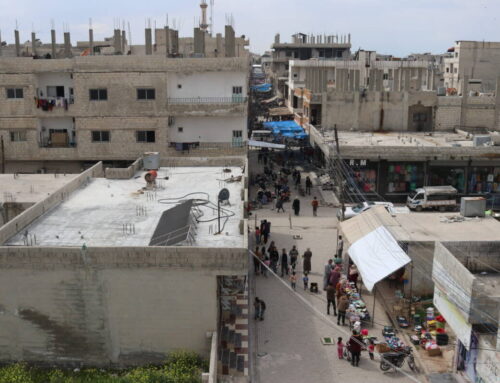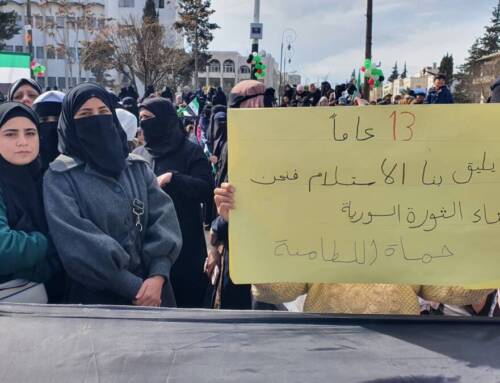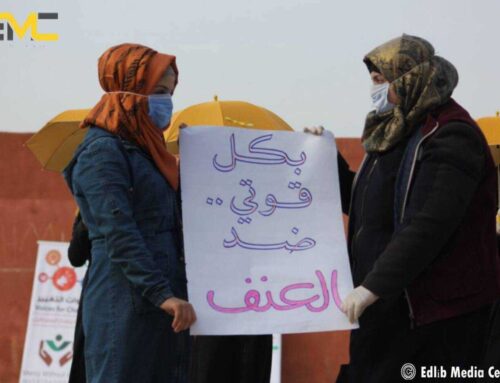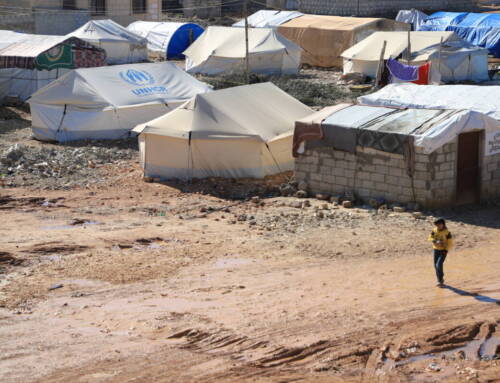‘Aleppo is a sad sight from above’: A rooftop garden provides sustenance
While gardening on his rooftop, Mustafa al-Amir looks out over […]
22 November 2016
While gardening on his rooftop, Mustafa al-Amir looks out over his east Aleppo neighborhood. Within the rubble he sees today, he recalls what was.
“Owners have abandoned their buildings, once occupied by late-night gatherings of friends,” al-Amir tells Syria Direct’s Mohammad al-Aseel and Celien Baker. “I see inside the abandoned homes of my neighbors because the balconies and windows have been destroyed by incessant shelling.”
Crouched between rows of Styrofoam crates packed with dirt, the 25-year-old Aleppo native spends his days tending to his garden, several stories above the ground.
Despite the hundreds of barrel bombs dropped over east Aleppo nearly every day, rooftops are the only place where East Aleppo residents such as Mustafa can grow produce.
“Our need makes us take risks,”says al-Amir. “As I see it, the siege will go on.”
Al-Amir began his rooftop garden in early September when regime forces took control of the southwestern Ramouseh district and sieged East Aleppo for the second time.
Last week, the last of east Aleppo’s food aid was distributed.
Q: How does it feel to look out over Aleppo from the rooftop where you garden? What does east Aleppo look like from above?
Aleppo is a sad sight from above. It’s destroyed and filthy.
Owners have abandoned their buildings, once occupied by late-night gatherings of friends.
I see inside the abandoned homes of my neighbors because the balconies and windows have been destroyed by incessant shelling. I see streets cut off from fallen buildings. The streets are stacked with piles of dust as parts of buildings and whole blocks have collapsed.
What I see are the remnants of life.

Q: What are you trying to accomplish through your rooftop garden? What types of vegetables do you grow and how are you able to meet your needs?
My goal is just to sustain myself and meet my daily needs. The vegetables aren’t for sale.
The regime’s encirclement has created a food shortage, and I’m just trying to compensate. Vegetables are hard to come by and prices are high, but they’re virtually the only source of food. We can barely meet our basic necessities.
I’m focused on growing vegetables that prevent disease. I grow chicory, chard, radishes and lettuce to make up for the nutrition our bodies lack.
After a harvest, I can meet around 75% of the needs of my parents and my five siblings. [Harvests] vary though. Some crops produce a harvest every two months, others every 40 days, and some only once.
Q: By planting on rooftops, aren’t you vulnerable to shelling? Why didn’t you choose another location?
There isn’t space for agriculture because of the dense arrangement of the residential buildings. The main reason [for using a rooftop] is for the direct sunlight, especially during the winter.
Our need makes us take risks.
Q: You began your mini-garden after the regime imposed a siege on east Aleppo for the second time. Why did you start such a project that requires time to yield results? At the time, did you think that the second siege would go on for a long time?
There’s no doubt that agriculture needs time and patience to get results, which made me hesitate to start this project. When the regime’s second siege began, I expected it to be long, just like the other encirclements of Waer, Homs, Ghouta and the Damascus countryside.
I didn’t want to waste time because winter would soon be approaching. As I see it, the siege will go on.







